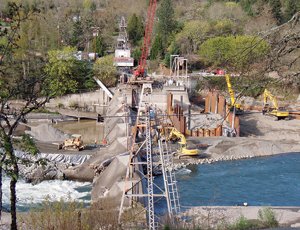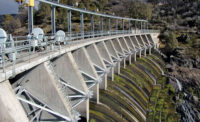Demolition began on June 1 at one of the largest-ever dam-removal projects in the U.S. Since 1921, the Savage Rapids Dam on the Rogue River near Grants Pass, Ore., has provided irrigation, but at a cost to the coho salmon that spawn in the river. A consent decree in 2000 capped a decade of legal fights and set the stage for the demolition.

The 39-ft-high, 500-ft-long concrete-buttress dam was built in 1921 by the Grants Pass Irrigation District for irrigation only and provides no electricity or flood control. But fish passages were substandard. Fish sometimes were blocked completely.
In 1991, Water Watch, a national environmental non-profit, tried to block GPID’s water-rights permit. The district responded with several lawsuits between 1995 and 2000, but when the federal government declared the coho endangered, “a judge sat all the parties down to solve the problem with a consent decree, which included a lobbyist who would get money for the project,” says Bob Hamilton, Bureau of Reclamation activity manager. The project is expected to open up 500 miles of additional spawning grounds to salmon and steelhead. This is “arguably the most important dam-removal project” in the U.S., says BuRec
Slayden Construction Group, Stayton, Ore., is general contractor for the $29.5-million project. Work started in 2007 with a timber-crib cofferdam and pumping station for continued irrigation. That was followed by a soldier-pile cofferdam to stem the flow downstream from the irrigation pumps. Admitting that “using a soldier pile is a bit old-school,” Darren Funk, Slayden project manager, says driving sheet piles into the base would be too hard because the rock under the river is an exceptionally hard type of granite.
In October, Slayden will excavate a pilot channel through the lake-bed sediment to allow the river to make its way through the original river bed. The majority of river sediment will be displaced during the winter when the irrigation system is not in service.
Slayden will build a second cofferdam on the other side of the river, allowing fish to travel on the opposite side while the dam is being removed. Project completion is expected in December.



Post a comment to this article
Report Abusive Comment